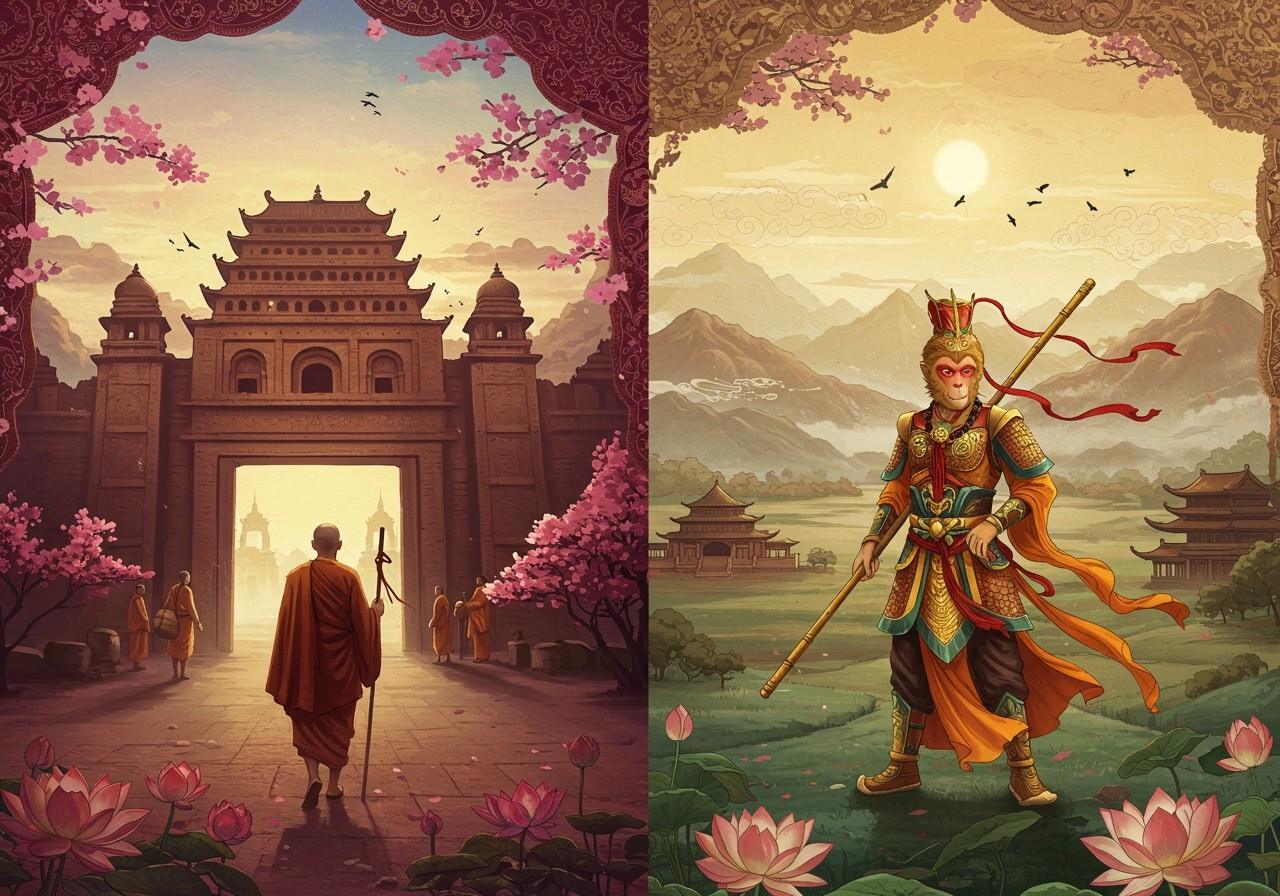
“Journey to the West,” a 16th-century Ming dynasty novel attributed to Wu Cheng’en, is a beloved classic of Chinese literature. This epic tale, one of the Four Great Classical Novels of China, weaves a captivating narrative of adventure and symbolism. At its heart lies the character of Xuanzang, a monk on a pilgrimage to India to retrieve sacred Buddhist texts. This blog post delves into the historical figure of Xuanzang, exploring his profound influence on the narrative and shedding light on the cultural and historical significance of this timeless story.
The Historical Xuanzang
Xuanzang, also known as Tang Sanzang, was a prominent Buddhist monk, scholar, and traveler who lived during the Tang Dynasty. Born in 602 AD, his quest for authentic Buddhist scriptures led him on a remarkable 17-year journey across thousands of miles and numerous countries. His meticulous records, documented in “Great Tang Records on the Western Regions,” offer invaluable insights into the diverse cultures, religious practices, and geographical landscapes he encountered. Xuanzang’s pilgrimage played a pivotal role in the spread of Buddhism within China, solidifying his status as a revered figure in Chinese history.
Xuanzang’s Journey and Its Fictional Adaptation
The novel “Journey to the West” draws inspiration from Xuanzang’s historical pilgrimage, embellishing it with fantastical elements. While Xuanzang’s real journey involved facing mundane yet life-threatening dangers, the novel incorporates encounters with demons, gods, and mythical creatures. His unwavering commitment to his mission and his spiritual fortitude remain central themes in both the historical and fictionalized accounts. “Journey to the West” masterfully blends historical facts with imaginative storytelling, creating a vibrant tapestry that celebrates Xuanzang’s enduring legacy.
Xuanzang and Sun Wukong: A Symbolic Partnership
The bond between Xuanzang and Sun Wukong, the Monkey King, is one of the most iconic relationships in “Journey to the West.” Sun Wukong, a mischievous yet powerful figure, acts as Xuanzang’s protector throughout their arduous journey. This dynamic symbolizes spiritual mentorship and guidance, reflecting Xuanzang’s role as a teacher. Sun Wukong’s transformation from a rebellious character to a disciplined disciple embodies the pursuit of enlightenment, mirroring Xuanzang’s own transformative journey. Their interplay explores themes of loyalty, redemption, and the quest for spiritual truth.
Xuanzang’s Portrayal in “Journey to the West”
Xuanzang, depicted as a compassionate and devout monk, is the heart of “Journey to the West.” His dedication to acquiring sacred texts for the benefit of all beings showcases his selfless nature. Throughout the novel, he embodies virtues such as patience, humility, and unwavering perseverance. Despite facing numerous trials and tribulations, his unwavering faith inspires his companions and readers alike. The novel portrays him as the embodiment of spiritual devotion, reflecting the real-life monk’s profound impact on Buddhism and Chinese culture. This portrayal is not only a tribute to his historical significance but also a symbol of the spiritual journey itself.
The Cultural and Historical Impact of Xuanzang’s Journey
Xuanzang’s real-life journey fostered a significant cultural exchange between China and India. By sharing Buddhist texts and teachings, he enriched Chinese spiritual and philosophical thought. His legacy is celebrated through various forms of art, literature, and religious practices. “Journey to the West” continues to inspire readers worldwide, showcasing Xuanzang’s enduring impact on cultural and historical narratives. His story serves as a timeless reminder of the power of perseverance, the pursuit of knowledge, and the profound impact of spiritual dedication.
Connecting with Tradition: How Poojn.in Supports Your Spiritual Journey
As we explore Xuanzang’s influence and his connection to Buddhist and Hindu traditions, consider enhancing your own spiritual practice with authentic items from Poojn.in:
- Pure Copper Water Vessels: Store water in traditional copper vessels, reminiscent of those used by ancient pilgrims. Copper is known for its purifying properties, adding a traditional touch to your daily rituals. Explore our collection of copper vessels.
- Meditation Cushions: Enhance your meditation practice with comfortable and supportive cushions, similar to those used by monks throughout history. Find the perfect cushion to support your posture and deepen your meditation experience. Learn more about meditation and mindfulness.
- Brass and Copper Incense Holders: Create a sacred atmosphere with beautifully crafted incense holders. These are ideal for meditation, prayer, or simply adding a touch of tranquility to your space. Discover the art of creating a peaceful environment.
- Prayer Beads (Mala): Choose from a variety of authentic prayer beads made from sandalwood, rudraksha, or crystal. These are essential tools for meditation, chanting, and deepening your spiritual connection. Explore the significance of prayer beads in different traditions.
Visit Poojn.in to discover our complete range of traditional ritual items. We are committed to providing authentic, high-quality products to support your spiritual journey. All items come with detailed usage instructions and are carefully packaged for safe delivery across India.
Conclusion
Xuanzang’s influence on “Journey to the West” is undeniable and enduring. His character embodies spiritual dedication, perseverance, and the pursuit of knowledge. His real-life journey fostered cultural exchange between China and India, enriching both traditions with his wisdom and teachings. Xuanzang’s legacy continues to inspire, reminding us of the power of faith, the importance of cultural understanding, and the transformative potential of the spiritual journey.


